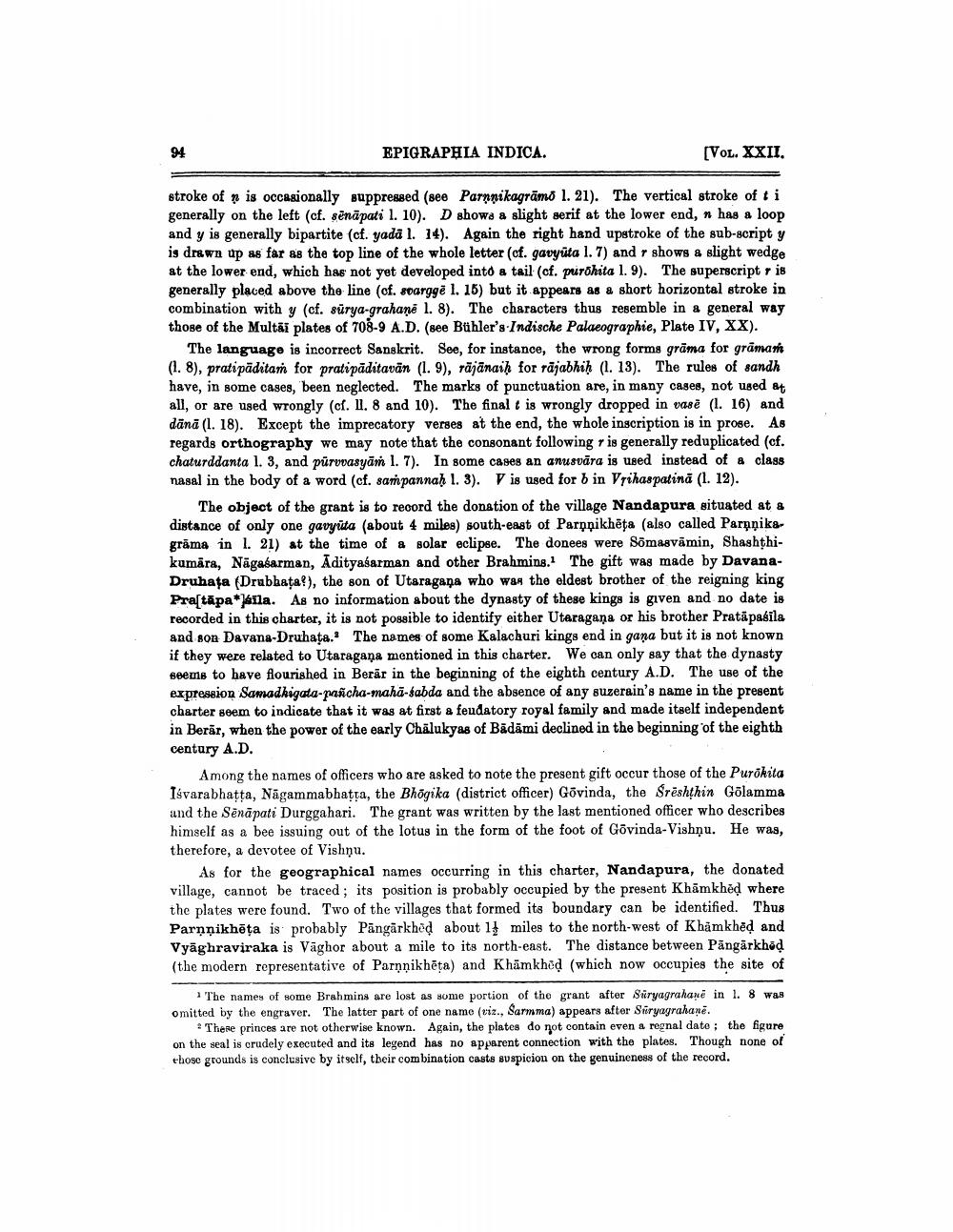________________
EPIGRAPHIA INDICA.
[VOL. XXII.
stroke of is occasionally suppressed (see Parnnikagrāmo l. 21). The vertical stroke of ti generally on the left (cf. sēnāpati 1. 10). D shows a slight serif at the lower end, has a loop and y is generally bipartite (cf. yada l. 14). Again the right hand upstroke of the sub-script y is drawn up as far as the top line of the whole letter (cf. gavyuta 1. 7) and shows a slight wedge at the lower end, which has not yet developed into & tail (cf. purohita 1. 9). The superscript is generally placed above the line (cf. soargge l. 15) but it appears as a short horizontal stroke in combination with y (cf. sürya-grahanë l. 8). The characters thus resemble in a general way those of the Multās plates of 708-9 A.D. (see Bühler's-Indische Palaeographie, Plate IV, XX).
The language is incorrect Sanskrit. See, for instance, the wrong forms gräma for grāmas (1.8), pratipăditań for pratipăditavän (1. 9), rājānaih for rájabhih (1. 13). The rules of sandh have, in some cases, been neglected. The marks of punctuation are, in many cases, not used at all, or are used wrongly (cf. 11. 8 and 10). The final t is wrongly dropped in vase (1. 16) and dānā (1. 18). Except the imprecatory verses at the end, the whole inscription is in prose. As regards orthography we may note that the consonant following is generally reduplicated (cf. chaturddanta 1.3, and pūrvvasyān 1. 7). In some cases an anusvāra is used instead of a class nasal in the body of a word (cf. sampannaḥ 1. 3). V is used for b in Vrihaspatină (1. 12).
The object of the grant is to record the donation of the village Nandapura situated at a distance of only one gavyüta (about 4 miles) south-east of Parpnikhēța (also called Parņņikagrāma in l. 21) at the time of a solar eclipse. The donees were Sömasvämin, Shashthikumara, Nägabarman, Adityasarman and other Brahmins. The gift was made by DavanaDruhata (Drubhata?), the son of Utaragana who was the eldest brother of the reigning king Prastāpa*411a. As no information about the dynasty of these kings is given and no date is recorded in this charter, it is not possible to identify either Utaragana or his brother Pratāpabila and son Davana-Druhata. The names of some Kalachuri kings end in gana but it is not known if they were related to Utaragana mentioned in this charter. We can only say that the dynasty seems to have flourished in Berär in the beginning of the eighth century A.D. The use of the expression Samadhigata-pancha-maha-sabda and the absence of any suzerain's name in the present charter seem to indicate that it was at first a feudatory royal family and made itself independent in Berār, when the power of the early Chälukyas of Bädāmi declined in the beginning of the eighth century A.D.
Among the names of officers who are asked to note the present gift occur those of the Purokita Isvarabhatta, Nägammabhatra, the Bhögika (district officer) Govinda, the Srështhin Gölamma and the Senapati Durggahari. The grant was written by the last mentioned officer who describes himself as a bee issuing out of the lotus in the form of the foot of Govinda-Vishņu. He was, therefore, a devotee of Vishņu.
As for the geographical names occurring in this charter, Nandapura, the donated village, cannot be traced; its position is probably occupied by the present Khamkhód where the plates were found. Two of the villages that formed its boundary can be identified. Thus Parņņikhēta is probably Pāngarkhed about 15 miles to the north-west of Khamkhed and Vyāghraviraka is Väghor about a mile to its north-east. The distance between Pängarkhod (the modern representative of Parmnikhēta) and Khămkhod (which now occupies the site of
The names of some Brahmins are lost as some portion of the grant after Suryagrahane in l. 8 was omitted by the engraver. The latter part of one name (viz., Sarnma) appears after Stiryagrahare.
There princes are not otherwise known. Again, the plates do not contain even a regnal dato; the figure on the seal is crudely executed and its legend has no apparent connection with the plates. Though none of chose grounds is conclusive by itself, their combination casts suspicion on the genuineness of the record.




